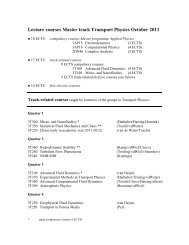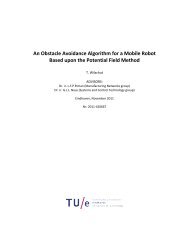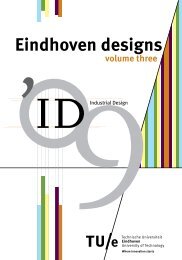Education guide 'Eindhoven designs' - Technische Universiteit ...
Education guide 'Eindhoven designs' - Technische Universiteit ...
Education guide 'Eindhoven designs' - Technische Universiteit ...
You also want an ePaper? Increase the reach of your titles
YUMPU automatically turns print PDFs into web optimized ePapers that Google loves.
Eindhoven designs / volume two 109<br />
next block or not (tentative decision).<br />
The assessor processes the outcomes<br />
in an assessment form. The showcase<br />
review – and possibly the exhibition –<br />
may have raised particular questions<br />
or topics, which can be addressed in<br />
the third step.<br />
• The third and last component of<br />
the assessment process is a meeting<br />
between assessor and student.<br />
This meeting gives the assessor the<br />
opportunity to either get clarification<br />
or discuss particular aspects or<br />
parts of the showcase in more detail.<br />
This way the assessor can fine-tune<br />
his/her evaluation of the student’s<br />
development and growth, and check<br />
the tentative verdict. For the student<br />
this meeting is an opportunity to<br />
demonstrate his overall development<br />
and growth in a different way: verbally<br />
as opposed to the visual/written<br />
communication in the showcase.<br />
Assessment as<br />
decision-making<br />
The formal decision that needs to be<br />
taken is whether or not the student can<br />
be promoted to the next block, and<br />
whether or not he/she will get 30 credits.<br />
There are three potential decisions: (1)<br />
the student is not promoted and does<br />
not get any credits. This is expressed by a<br />
‘Hold’ or H-verdict, which means that the<br />
student has to do the same block again,<br />
but with different learning activities;<br />
(2) the student is promoted and gets<br />
30 credits. This is represented by a<br />
‘Promotion’ or P-verdict; (3) the student is<br />
conditionally promoted. This is captured<br />
by a ‘Conditional’ or C-verdict. The<br />
student does not get the 30 credits yet<br />
but can earn them at the next assessment<br />
by fulfilling the conditions.<br />
This formal decision is arrived at in two<br />
steps:<br />
• As a first step the assessor takes a<br />
tentative decision, based on the exhibition,<br />
showcase review and meeting<br />
with the student;<br />
• The second step in the decision-making<br />
process is the assessor meeting.<br />
Here a group of assessors discuss their<br />
tentative verdicts and the ground(s) on<br />
which they arrived at these verdicts.<br />
These meetings are arranged in such<br />
a way that the student’s competency<br />
coach is among the participants. If<br />
applicable, assessors also discuss<br />
whether and why students qualify<br />
for ‘excellence’. This discussion may<br />
result in a modification of some of the<br />
verdicts and corresponding adjustments<br />
of the justification. It is the<br />
assessor who, at this meeting, decides<br />
on the final verdict for the students<br />
he/she has assessed, taking into account<br />
the preceding discussion. These<br />
assessor meetings also serve the<br />
purpose of ensuring a common view<br />
of the developmental stages for the<br />
competence of designing and increasing<br />
the validity of the assessments.

















